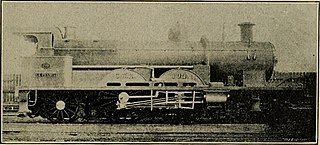
The Great Western Railway 4000 or Star were a class of 4-cylinder 4-6-0 passenger steam locomotives designed by George Jackson Churchward for the Great Western Railway (GWR) in 1906 and introduced from early 1907. The prototype was built as a 4-4-2 Atlantic. They proved to be a successful design which handled the heaviest long-distance express trains, reaching top speeds of 90 mph (145 km/h), and established the design principles for GWR 4-cylinder classes over the next twenty-five years.

The Great Bear, number 111, was a locomotive of the Great Western Railway. It was the first 4-6-2 (Pacific) locomotive used on a railway in Great Britain, and the only one of its type built by the GWR.

The GWR 4100 Class was a class of steam locomotives in the Great Western Railway (GWR) of the United Kingdom.
The Great Western Railway 3800 Class, also known as the County Class, were a class of 4-4-0 steam locomotives for express passenger train work introduced in 1904 in a batch of ten. Two more batches followed in 1906 and 1912 with minor differences. They were designed by George Jackson Churchward, who used standard components to produce a four-coupled version of his Saint Class 4-6-0s.

The Great Western Railway 2900 Class or Saint Class, which was built by the Great Western Railway's Swindon Works, incorporated several series of 2-cylinder passenger steam locomotives designed by George Jackson Churchward and built between 1902 and 1913 with differences in the dimensions. The majority of these were built as 4-6-0 locomotives; but thirteen examples were built as 4-4-2. They proved to be a highly successful class which established the design principles for GWR 2-cylinder classes over the next fifty years, and influenced similar classes on other British railways.

The Great Western Railway (GWR) 4200 Class is a class of 2-8-0T steam locomotives.

The Great Western Railway (GWR) 6800 Class or Grange Class was a mixed-traffic class of 4-6-0 steam locomotive, built to replace the GWR 4300 Class 2-6-0. There were 80 in the class, all built at the Swindon works, using some reconditioned parts from withdrawn 4300 Class locomotives.

The Great Western Railway (GWR) 4500 Class or Small Prairie is a class of 2-6-2T steam locomotives.

The Great Western Railway (GWR) 4700 Class was a class of nine 2-8-0 steam locomotives, designed by George Jackson Churchward. They were introduced in 1919 for heavy mixed-traffic work. Although primarily designed for fast freight, the class also sometimes hauled passenger trains, notably heavy holiday expresses in the summer months. They were unofficially nicknamed "Night Owls" because they were primarily designed to haul goods during the night and they could be seen simmering in the daylight, awaiting their nocturnal duties.
The Great Western Railway (GWR) 3600 Class was a class of 2-4-2T side tank steam locomotive, designed by William Dean and built at Swindon in three lots in 1900-1903:

The Dean Single, 3031 Class, or Achilles Class was a type of steam locomotive built by the British Great Western Railway between 1891 and 1899. They were designed by William Dean for passenger work. The first 30 members of the class were built as 2-2-2s of the 3001 Class.

La France, number 102, was a locomotive of the Great Western Railway. It was bought by G.J. Churchward to evaluate French locomotive practice, and particularly the effect of compounding.

The Queen Class was Joseph Armstrong's last class of 2-2-2 express engine for the Great Western Railway, larger than the Sir Daniel Class of about a decade earlier. They worked express trains for almost 30 years, and were in effect the predecessors of the larger Singles of William Dean.
The 927 Class or Coal Goods was series of 20 0-6-0 freight steam locomotives designed by Joseph Armstrong for the Great Western Railway, and built at Swindon Works in 1874. They were numbered in the series 927–946.
Between 1854 when the Shrewsbury and Chester and Shrewsbury and Birmingham Railways were absorbed by the Great Western Railway, and 1864 when he moved south to Swindon Works, Joseph Armstrong occupied the post of the GWR's Locomotive Superintendent, Northern Division, at Wolverhampton Works. For ten years the task of providing new locomotives for the GWR's newly acquired standard gauge lines fell jointly to Armstrong and to his superior Daniel Gooch, the railway's principal Locomotive Superintendent who was based at Paddington.

The 2602 Class was a series of steam locomotives designed by William Dean and built at the Swindon Works of the Great Western Railway.
The 3201 or Stella Class was a class of standard gauge 2-4-0 steam locomotive, designed by William Dean and built at Swindon Works for the Great Western Railway in 1884 and 1885.
The 3206 or Barnum Class consisted of 20 locomotives built at Swindon Works for the Great Western Railway in 1889, and was William Dean's most successful 2-4-0 design. Numbered 3206–3225, they were the last GWR locos built at Swindon with "sandwich" frames.

The GWR 101 Class consisted of a single experimental 0-4-0T side-tank steam locomotive. It was built at GWR Swindon Works under the direction of George Jackson Churchward in June 1902.

The 4600 Class was a 4-4-2T steam locomotive built by the Great Western Railway in 1913. It was one of the GWR standard classes with two outside cylinders.














